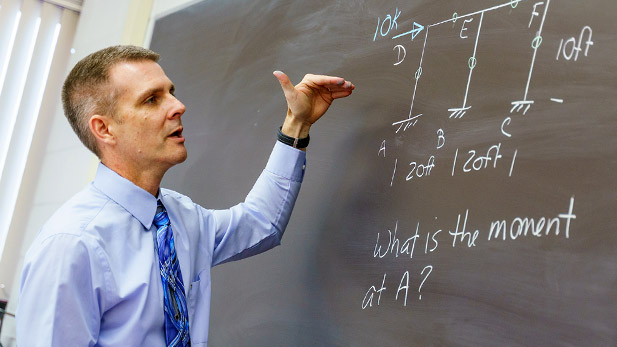Educating Future Engineers to be Intuitive Problem Solvers

Professor James Hanson interviewed structural engineers throughout America to develop concepts for his new first-of-its-kind civil engineering textbook that introduces basic and advanced structure analysis techniques.
Tomorrow’s civil engineers may have all of the high-tech tools to design bigger and better structures, but may also lack the analytical skills to know whether their computer-provided results are reasonable or could be dangerously flawed.
Compounding the problem, says civil and environmental engineering professor James H. Hanson, is the fact that a generation of engineers who started their careers before computers, with all the skills to solve problems through hand calculations, are retiring. This will leave their jobs in the hands of professionals who rely on the computer, while not knowing if its outputs are reasonable or not.
That’s why Hanson reached out to find how experienced engineers find errors in their results. In an effort supported by the National Science Foundation, he personally interviewed 35 structural engineers, with experience ranging from 1 to 55 years, at 10 design firms across the country.
He learned that how most errors are caught can be taught. Less than a quarter of errors are found based on previous experience.
Hanson says, “Using analysis results without verifying their reasonableness is irresponsible and dangerous. Engineers are responsible for their results. They can’t transfer that responsibility to the tools used to generate the results. Never again should we hear a student or junior engineer say ‘but that is what the computer told me.’ If we can eradicate that phrase, my career would be well spent.”
Hanson is a fellow of the American Concrete Institute, has received awards from the American Society of Engineering Education and ACI for excellence and innovation in teaching and also has earned Rose-Hulman’s Outstanding Teacher Award. He is a consultant to various industrial clients and has previously been a structural designer and a U.S. Army engineer officer.
Lessons learned from Hanson’s interviews of practicing structural engineers became the basis of a seven-year project to develop a first-of-its-kind civil engineering textbook, Structural Analysis: Skills for Practice, that introduces basic and advanced structure analysis techniques. There’s an emphasis on developing intuition, with explicit training on tools for evaluating analysis results.
The textbook, being adopted by faculty in classrooms throughout the country, also connects theory with real-world examples. Every example and homework problem starts with a photo or rendering of a structure and a description of the situation that requires analysis. There also are detailed examples, problems that are not just about executing a concept, but a place to learn. Hanson intentionally added text to explain why certain steps are taken in the example and what the results mean, without skipping steps and including units throughout the calculations.
Coverage of topics used in engineering practice, but not covered in other textbooks, includes the application of lateral loads, distribution of lateral loads by flexible and rigid diaphragms, and approximate analysis of braced frames. Also, there are areas teaching how to approximate lateral displacements and in-plane diaphragm forces. Several of these topics are on the professional engineer and structural engineer exams.